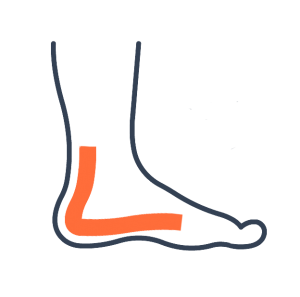The tibialis posterior tendon passes down the back of the leg, inside of the ankle and inserts into a bone on the inside of the foot and it stops your foot from flattening out too much. It is used to plantarflex the foot as in going up on your toes, and invert the foot which is turning the soles of the feet inwards. Injury or degeneration of the tendon where it inserts into the foot bones causes pain on the inside of the foot which may radiate along the length of the tendon.
Pain is due to degeneration of the tendon rather than inflammation and sometimes there is an accessory bone causing rubbing or even a partial avulsion where the tendon pulls away from the navicular.

Tibialis Posterior Tendinopathy Symptoms
Symptoms include:
- Pain on the inside of the foot which may radiate along the length of the tendon under the foot.
- A creaking sensation called crepitus can often be felt when the tendon moves.
- Pain is made worse by passive eversion (turning out the foot) or resisted inversion (turning in). This means if a therapist turns the foot outwards to stretch the tibialis posterior or the patient turns the soles of the feet inwards as the therapist resists to stress the tendon.
Aside from the pain, if the tendon does fail, it may result in a collapsed arch and flat feet.
Tibialis Posterior Tendinopathy Cause
The causes of tibialis posterior tendonitis include prolonged stretching of the foot and ankle into eversion. This happens with pronated feet or in some sports such as speed skating or running on tight bends.
How to treat Tibialis Posterior Tendinopathy
COLD THERAPY: Apply ice to reduce pain and inflammation. Do this with a sock on or use a wet tea towel. Commercially available hot and cold packs are often more convenient. Cold therapy can be applied for 10 minutes every hour for the first 24 to 48 hours on the sore area, and after a week, heat may be more beneficial. Some people do hot and cold treatments together.
STRETCHING: When pain levels allow, you should start stretching exercises for the tibialis posterior and calf muscles. Specific strengthening for the tibialis posterior muscle involves inversion against resistance which I can demonstrate for you in the clinic.
FRICTION MASSAGE: Other management we employ in the clinic may be cross friction to the tendon and deep tissue massage to the tibialis posterior and calf muscles. Depending on the severity, we will advise and monitor a rehabilitation program to strengthen the ankle and the tibialis posterior muscle.
ORTHOTICS: We may prescribe orthotic inserts to correct poor foot biomechanics. If the tendon is ruptured, then it must be surgically repaired.
